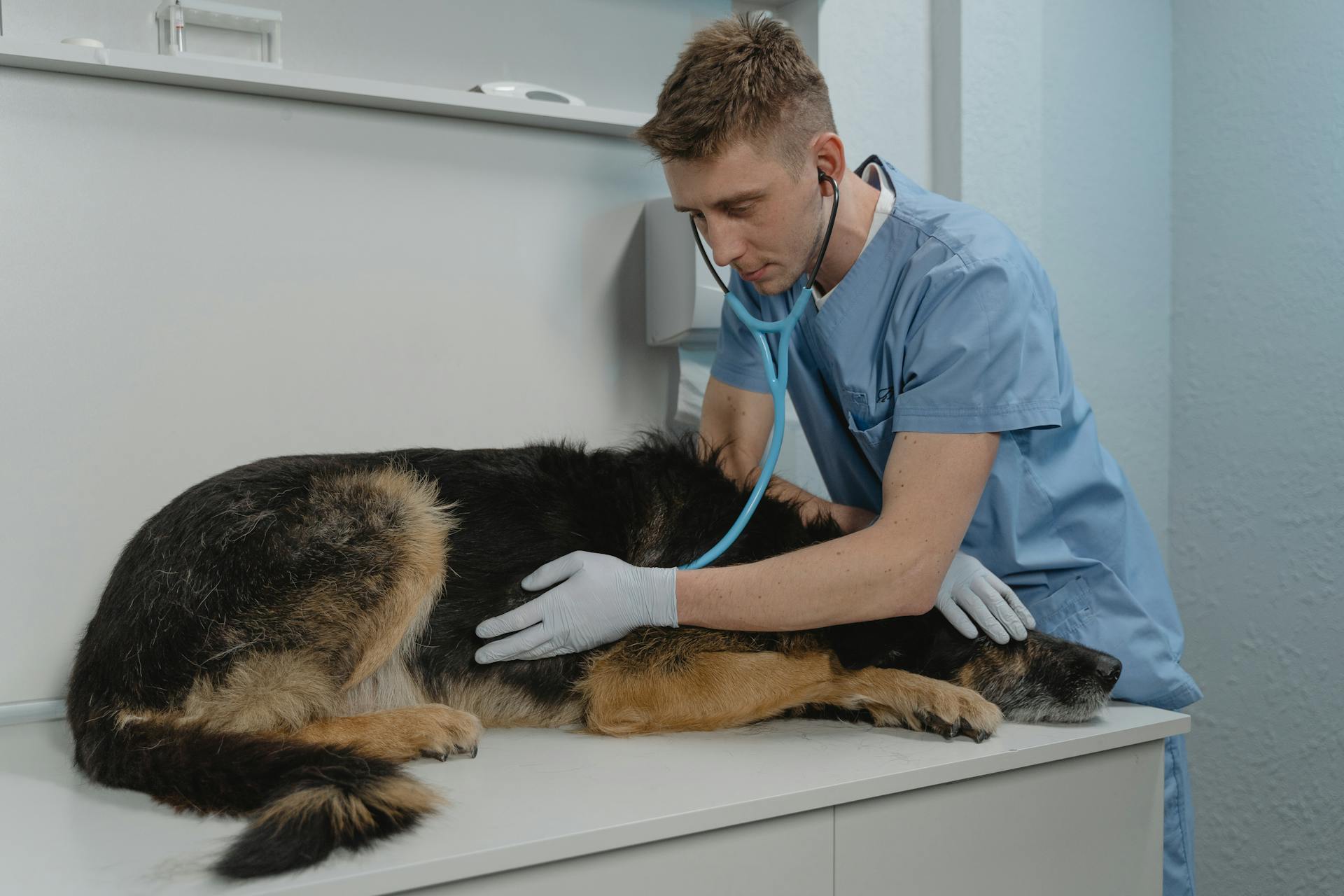
Canine metastatic cancer is a serious and complex disease that affects many dogs. According to research, metastatic cancer accounts for 90% of all canine cancer deaths.
Early detection is key to preventing metastatic cancer. Regular check-ups and screenings can help identify cancer at an early stage, when it's more treatable.
Chemotherapy is a common treatment option for canine metastatic cancer. It can be used alone or in combination with other therapies to slow the growth of cancer cells and improve quality of life.
Causes and Prevention
Adenocarcinoma, a type of metastatic cancer, has an unknown cause, making prevention impossible.
Spaying female dogs before their first heat decreases the likelihood of mammary adenocarcinoma, and eliminates the possibility of ovarian carcinoma.
Neutering male dogs eliminates the possibility of adenocarcinoma of the testicle.
Spaying reduces the risk of mammary cancer in dogs, especially when done before 12 months of age.
Adenocarcinoma is not contagious.
Causes of Metastasis
Metastasis, the process by which cancer spreads from one part of the body to another, is a complex and multifaceted phenomenon. Research has identified several key factors that contribute to its development.
Old age is a significant risk factor for metastasis. As we age, our cells undergo more mutations, increasing the likelihood of cancerous growth. This is especially true for dogs, where age is a major contributor to cancer development.
Chemical exposure has also been linked to metastasis. Some chemicals, such as those found in pesticides and industrial pollutants, can damage our cells and increase the risk of cancer. This highlights the importance of a safe and healthy environment.
Genetics play a role in metastasis, with some breeds of dogs being more prone to cancer due to their genetic makeup. This is a sobering reminder of the importance of responsible breeding practices.
Environmental influence can also contribute to metastasis. This includes exposure to pollutants, radiation, and other environmental stressors that can increase the risk of cancer.
Here are some key factors that contribute to metastasis:
- Old age
- Chemical exposure
- Genetics
- Environmental influence
Prevention

Spaying female dogs before their first heat can decrease the likelihood of mammary adenocarcinoma.
Neutering male dogs eliminates the possibility of adenocarcinoma of the testicle.
Spaying reduces the risk of mammary cancer in dogs, and spaying female pets before 12 months of age can significantly reduce this risk.
Half of all breast neoplasms in dogs and greater than 85% of all breast neoplasms in cats are malignant.
Adenocarcinoma is not contagious.
Curious to learn more? Check out: Canine Female Reproductive Anatomy
Symptoms and Diagnosis
Symptoms of canine metastatic cancer can be quite varied and depend on the primary tumor location and where the cancer cells have traveled. Inflammation, redness or rash, and discolored skin are common symptoms.
The areas where the neoplasia ends up can also send out signs of problems. For example, if the cancer has spread to the chest and abdomen, you may notice edema or fluid retention. If the cancer has spread to the mouth or gums, you might see a mass or lump, bleeding, foul breath, trouble eating, or appetite loss.
Some common symptoms of canine metastatic cancer include coughing, labored breathing, gasping for breath, weight loss, wheezing, and coughing up blood. If the cancer has spread to the abdominal area, you may notice edema, jaundice, vomiting, diarrhea, weakness, and sleepiness.
Here are some common symptoms of canine metastatic cancer, grouped by body system:
- Chest and Abdomen: edema (fluid retention), coughing, labored breathing, gasping for breath, weight loss, wheezing, coughing up blood
- Mouth and Gums: mass or lump, bleeding, foul breath, trouble eating, appetite loss
- Abdominal Area: edema, jaundice, vomiting, diarrhea, weakness, sleepiness
- Urinary System: edema, frequent urination, lack of urination, abnormal thirst, vomiting, appetite loss, weight loss
What Are Tumors?
Tumors are not just a scary word, but a physical manifestation of a neoplasm, which is an uncontrolled, abnormal growth of cells or tissues in the body.
A tumor can be a swelling or mass that forms as a result of this abnormal growth, and it's often used interchangeably with the word "neoplasm".
Benign tumors tend to grow slowly and don't invade the surrounding tissues, while malignant tumors can be unpredictable and spread to other parts of the body.
It's worth noting that not all tumors are cancers, only malignant neoplasms are truly cancers, so if you're diagnosed with a tumor, it's essential to get a proper diagnosis to determine its nature.
Symptoms of Metastatic
If you suspect that your dog has metastatic cancer, there are several signs you should look out for. Lumps or growths can appear on the skin, and in some cases, the entire body can become swollen due to fluid retention.
Some symptoms are more specific to certain areas of the body. For example, a mass or lump in the mouth or gums can cause bleeding, foul breath, and trouble eating. In some cases, the dog may even cough up blood.
Other symptoms can be more general, such as weight loss, weakness, and vomiting. These symptoms can be caused by the cancer cells spreading to various parts of the body, including the abdominal area, where they can cause edema, jaundice, and vomiting.
Here are some common symptoms of metastatic cancer in dogs:
• Lumps or growths on the skin
• Mass or lump in the mouth or gums
• Bleeding
• Foul breath
Check this out: Canine Mouth Cancer Life Expectancy
• Trouble eating
• Coughing
• Weight loss
• Weakness
• Vomiting
• Diarrhea
• Edema (fluid retention) in the abdominal area
• Jaundice (yellowing of skin and mucous membranes)
• Sleepiness
Keep in mind that these symptoms can also be caused by other conditions, so it's essential to consult with your veterinarian for a proper diagnosis.
How Is Diagnosed?
Diagnosing cancer in dogs is a thorough process that involves a combination of physical examination, laboratory tests, and imaging. A veterinarian will need to give your pet a thorough examination including height, weight, pulse, oxygen levels, breath sounds, abdominal palpation, pupil reaction time, blood pressure, temperature, and respirations.
Telling the veterinarian the symptoms you've noticed and any medication given to your dog is crucial for an accurate diagnosis. Necessary laboratory tests include blood counts and a serum biochemistry panel to check for abnormal levels of protein, blood cell counts, kidney function, liver panel, glucose level, and a packed cell volume (PCV) to check for dehydration and electrolyte balance.

Radiographs (x-rays) of the affected area will be done next to look for metastatic neoplasms and the primary tumor. An MRI, CT scan, and ultrasound are usually done next to get better views of the tumor.
A biopsy will be taken by fine needle aspiration, which will help the veterinarian know exactly where to look for the primary tumor. Imaging can be very helpful, especially in places that are difficult to access, such as an MRI for a brain tumor.
Blood tests, such as the Cadet tests for certain blood or bladder cancers, and the Nu.Q Veterinary Cancer Screening Test and the OncoK9 tests, can help determine if cancer is likely, but they don't specify the type of cancer.
Treatment and Costs
Treating canine metastatic cancer requires a team of specialists, including surgical oncologists, radiation oncologists, and medical oncologists, who work together to develop an integrated treatment plan. This approach has led to better outcomes for dogs with cancer.
The treatment options for dogs with metastatic cancer include surgery, chemotherapy, radiation, cryosurgery, hyperthermia, and immunotherapy. Each type of cancer requires individual care, and treatment may involve one or a combination of these therapies.
Pain management is an essential aspect of treating canine metastatic cancer, and your veterinarian may recommend dietary changes or other therapies to help your pet better respond to treatment. Your pet's overall health is crucial in determining the success of treatment.
The cost of treating canine metastatic cancer varies greatly, depending on the type of cancer and the treatment options chosen. Some cancers can be treated for a few hundred dollars, while more complicated cases can cost $15,000 or more.
Here are some estimated costs associated with treating canine metastatic cancer:
It's essential to work with a veterinary oncologist to determine the best treatment plan for your dog and to discuss the potential costs and risks associated with each option.
Specific Types and Breeds
Some breeds are more prone to cancer, and it's essential to know which ones. Golden retrievers are commonly affected by cancer.
Certain breeds have a higher risk of developing specific types of cancer. Bernese mountain dogs are often affected by cancer, as are Rottweilers.
Boxers and beagles are also at a higher risk of developing cancer. Mixed-breed dogs may be a little more resilient to cancer, but they can still be affected.
Scottish terriers (Scotties) and West Highland white terriers (westies) are also breeds that are commonly affected by cancer.
Mortality and Statistics
Approximately 1 in 4 dogs will develop neoplasia at some stage in their life. Almost half of dogs over the age of 10 will develop cancer.
Dogs get cancer at roughly the same rate as humans.
How Common Are?
More than 50% of dogs over the age of 10 will have cancer. It's a sobering statistic that highlights the importance of regular veterinary check-ups.
The most common types of cancer in dogs are melanomas, mast cell tumors, lymphomas, and bone cancers. These are the big ones that veterinarians see frequently.
Almost half of dogs over the age of 10 will develop cancer. That's a staggering number that underscores the need for pet owners to be aware of the risks.
Dogs get cancer at roughly the same rate as humans. It's a reminder that our furry friends are not immune to this disease.
Approximately 1 in 4 dogs will, at some stage in their life, develop neoplasia. It's a condition that's worth understanding and discussing with your veterinarian.
Dog Mortality
Some cancers in dogs are much more likely to be fatal than others.
Cancers that have an impact on the whole body have a higher rate of being fatal.
It's crucial to meet with a veterinary oncologist to find out your options.
Cancers that are localized in one particular area are much more likely to be curable.
Mast cell tumors, soft tissue sarcomas, and some of the anal sac tumors have cures.
Frequently Asked Questions
How long can dogs live with metastatic cancer?
Dogs with metastatic cancer typically live for about 2 months after diagnosis, but survival time can vary depending on individual circumstances. If you're concerned about your dog's cancer, learn more about treatment options and what to expect.
When to euthanize a dog with cancer?
Consider euthanizing your dog with cancer if they experience unmanageable pain, unremovable tumors, or a significant decline in quality of life, leading to symptoms like lethargy, incontinence, or difficulty breathing. Your pet's well-being is in your hands, and making this difficult decision requires careful consideration.
Featured Images: pexels.com


